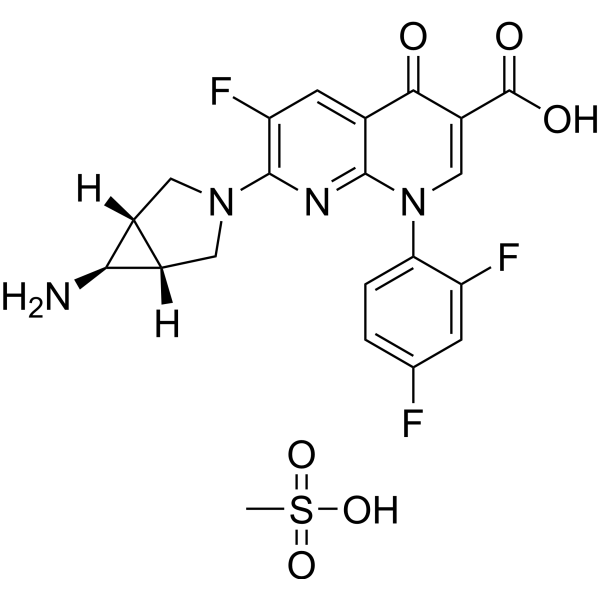
Trovafloxacin mesylate
CAS No. 147059-75-4
Trovafloxacin mesylate( —— )
Catalog No. M26492 CAS No. 147059-75-4
Trovafloxacin mesylate is an effective and selective inhibitor of pannexin 1 channel (PANX1, IC50 = 4 μM).
Purity : >98% (HPLC)
 COA
COA
 Datasheet
Datasheet
 HNMR
HNMR
 HPLC
HPLC
 MSDS
MSDS
 Handing Instructions
Handing Instructions
| Size | Price / USD | Stock | Quantity |
| 5MG | 65 | In Stock |


|
| 10MG | 110 | In Stock |


|
| 25MG | 177 | In Stock |


|
| 50MG | 347 | In Stock |


|
| 100MG | 520 | In Stock |


|
| 200MG | Get Quote | In Stock |


|
| 500MG | Get Quote | In Stock |


|
| 1G | Get Quote | In Stock |


|
Biological Information
-
Product NameTrovafloxacin mesylate
-
NoteResearch use only, not for human use.
-
Brief DescriptionTrovafloxacin mesylate is an effective and selective inhibitor of pannexin 1 channel (PANX1, IC50 = 4 μM).
-
DescriptionTrovafloxacin mesylate is an effective and selective inhibitor of pannexin 1 channel (PANX1, IC50 = 4 μM). Trovafloxacin mesylate exhibits potent activity against Gram-positive, Gram-negative, and anaerobic organisms. Trovafloxacin mesylate blocks the DNA gyrase and topoisomerase IV activity.(In Vitro):Trovafloxacin mesylate is an inhibitor of TO-PRO-3 uptake by apoptotic cells and inhibits ATP release from apoptotic cells. Trovafloxacin mesylate does not inhibit caspase 3/7 activation, or caspase-mediated PANX1 cleavage during apoptosis. Trovafloxacin mesylate is equally active against both penicillin-susceptible and -resistant pneumococci, with MICs of 0.06-0.25 mg/mL reported for more than 700 isolates. The MICs of Trovafloxacin mesylate at which 90% of isolates are inhibited for 55 isolates of pneumococci is 0.125 μg/mL. Trovafloxacin mesylate prolongs TNF-induced activation of MAPKs and IKKα/β activation in HepG2 cells. Trovafloxacin mesylate (20 μM; 24 hours) and tumor necrosis factor (TNF; 4 ng/mL) incubation induces apoptosis and increases leakage of lactate dehydrogenase (LDH). Trovafloxacin mesylate (20 μM; 24 hours) and TNF (4 ng/mL) incubation increases expression of early NF-κB-related factors A20 and IκBα.(In Vivo):Trovafloxacin mesylate induces severe liver toxicity associated with vast apoptotic areas in the liver, increased serum levels of alanine amino transferases (ALT) and pro-inflammatory cytokines when administered in combination with lipopolysaccharide (LPS) or TNF to mice. In male C57BL/6 J mice, Trovafloxacin mesylate (150 mg/kg; oral administration) disrupts TNF-induced p65 nuclear translocation. Trovafloxacin mesylate treatment increases expression of early NF-κB-related factors A20 and IκBα.
-
In VitroTrovafloxacin (20 μM; 24 hours; HepG2 cells) and tumor necrosis factor (TNF; 4 ng/mL) incubation induces apoptosis and increases leakage of lactate dehydrogenase (LDH) in HepG2 cells.Trovafloxacin (20 μM; 24 hours; HepG2 cells) and TNF (4 ng/mL) incubation increases expression of early NF-κB-related factors A20 and IκBα.Trovafloxacin prolongs TNF-induced activation of MAPKs and IKKα/β activation in HepG2.Trovafloxacin is a potent inhibitor of TO-PRO-3 uptake by apoptotic cells. Trovafloxacin also inhibits ATP release from apoptotic cells. Trovafloxacin does not inhibit caspase 3/7 activation, or caspase-mediated PANX1 cleavage during apoptosis.Trovafloxacin is equally active against both penicillin-susceptible and -resistant pneumococci, with MICs of 0.06-0.25 mg/mL reported for more than 700 isolates. The MICs of Trovafloxacin at which 90% of isolates are inhibited for 55 isolates of pneumococci is 0.125 μg/mL. Apoptosis Analysis Cell Line:HepG2 cells Concentration:20 μM Incubation Time:24 hours Result:Showed a gradual increase of Annexin V-staining and an increased leakage of lactate dehydrogenase (LDH) at 24 h.RT-PCR Cell Line:HepG2 cells Concentration:20 μM ncubation Time:24 hours Result:Caused a higher increase in the transcription of A20 and IκBα in HepG2 cells.
-
In VivoTrovafloxacin (150 mg/kg; oral administration; male C57BL/6 J mice) treatment disrupts TNF-induced p65 nuclear translocation. Trovafloxacin treatment increases expression of early NF-κB-related factors A20 and IκBα.Trovafloxacin, when administered in combination with lipopolysaccharide (LPS) or TNF to mice induces severe liver toxicity associated with vast apoptotic areas in the liver, increased serum levels of alanine amino transferases (ALT) and pro-inflammatory cytokines. Animal Model:Male C57BL/6 J mice (9-11-week-old) injected with recombinant murine TNF ion Dosage:150 mg/kg Administration:Oral administration; once Result:Showed a greater number of cells with increased nuclear/cytoplasmic p65 ratio in liver.
-
Synonyms——
-
PathwayOthers
-
TargetOther Targets
-
RecptorCOMT| Human Endogenous Metabolite| MAO-A| MAO-B
-
Research Area——
-
Indication——
Chemical Information
-
CAS Number147059-75-4
-
Formula Weight512.46
-
Molecular FormulaC21H19F3N4O6S
-
Purity>98% (HPLC)
-
SolubilityIn Vitro:?DMSO : 125 mg/mL (243.92 mM)
-
SMILESCS(O)(=O)=O.[H][C@@]12CN(C[C@]1([H])[C@H]2N)c1nc2n(cc(C(O)=O)c(=O)c2cc1F)-c1ccc(F)cc1F
-
Chemical Name——
Shipping & Storage Information
-
Storage(-20℃)
-
ShippingWith Ice Pack
-
Stability≥ 2 years
Reference
1.Andrade JM, et al. Combining in vitro and in silico approaches to evaluate the multifunctional profile of rosmarinic acid from Blechnum brasiliense on targets related to neurodegeneration. Chem Biol Interact. 2016 Jul 25;254:135-45.
molnova catalog



related products
-
Phytin
Phytin and magnesium citrate have hypocalciuric effect , they can reduce urinary calcium excretion in rats fed on high-calcium diets.
-
Mephenesin
Mephenesin is an NMDA receptor antagonist, is a centrally acting muscle relaxant.
-
Adipic acid
From an industrial perspective, it is the most important dicarboxylic acid, mainly as a precursor for the production of nylon.



 Cart
Cart
 sales@molnova.com
sales@molnova.com


